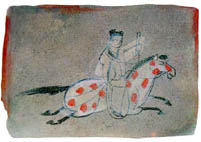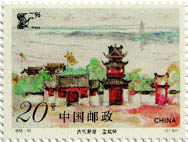|
Messenger "Fish" and Birds
A souvenir stamp sheetlet issued in November 1990 for the Third All-China Philatelic Federation Congress takes the ancient Gusu (present-day Suzhou) Post as its motif, and its background sheet is printed with the ancient character "yu," or "fish." The prototype of this pictograph is actually a sketch of fish, and its use on a commemorative stamp recalls another post-related Chinese idiom, "yu chuan chisu," or "Fish delivers foot-long plain silk."
Apart from bamboo and wooden slips, the ancient Chinese also wrote letters on strips of plain silk. During the Tang Dynasty (618-907), a silk letter measured about a Chinese foot in length, and a letter was therefore called "chisu," or "foot-long plain silk." To deliver it, a "chisu" letter was usually tied into the shape of double fish, hence the term "yu chuan chisu." Moreover, the "envelope" for a "chisu" was fashioned out of a pair of wooden plates cut into the shape of a fish.
Before paper was invented, letters written on bamboo, wooden slips or silk would be sandwiched between these two fish-shaped pieces, whose outer surfaces would be carved with grooves to accommodate the cord that bound them together. Many ancient poems include such terms as "fish letter," "fish silk" and "double carp," which allude to this early postal service.
In October 1998, China Post issued a set of four postcards to celebrate the 22nd Universal Postal Union Congress in Beijing. Three of the postcards depict a flying bird, in acknowledgment of the ancient idiom "qingniao chuan shu," or "A bluebird delivers a message" -- a far older myth than the stories of wild geese and fish.
Chinese mythology has it that the Queen Mother of the West had three bluebirds as her messengers. Wherever she went, one of the birds would fly across the mountains and rivers to deliver her missives. Consequently, the ancient Chinese worshipped bluebirds as messengers of auspiciousness. In later mythology, bluebirds evolved into the "Queen of Birds" -- the mythical phoenix, which rises intact from the ashes of its own destruction.
 |
| A sheetlet depicting a mounted estafette issued in 1982. |
From Beacons to Mounted Estafette
The souvenir stamp sheetlet issued in 1994 for the Fourth All-China Philatelic Federation Congress features the remains of the Han Dynasty Kizil Beacon Tower in Xinjiang's Kuqa County. The tower was built 2,000 years ago during the Western Han Dynasty (206 BC-AD 24), and its remains are about 15 meters tall.
In ancient times, beacons were built at regular intervals in frontier areas. During the night, fires would be lit to pass messages along the route, and during the day smoke took over the function. Dried wolf excrement was the best material for generating thick smoke, therefore a beacon was also known colloquially as a "wolf smoke tower." It was an essential installation during the construction of the Great Wall.
Beacons were first adopted as a means of communication for military purposes 3,000 years ago, around the turn of the Shang (c. 1600-1046 BC) and Zhou (c.11th century to 476 BC) dynasties, and they remained in use for more than 2,000 years. The Han Dynasty built more beacon towers than any other dynasty.
Beginning in the Spring and Autumn and Warring States periods (770-221 BC), chariots and horses were employed to enrich the beacon communication system, and the ancient mounted postal system came into being. After Emperor Qinshihuang united China in 221 BC, he built many postal roads and stations and expanded the system into an established institution.
The mounted estafette shown on the stamp sheetlet for the First All-China Philatelic Federation Congress is modeled after an estafette, or military relay courier, as depicted on a brick picture found in a tomb from the Wei (Kingdom)-Jin (Dynasty) Period (220-420) in the Gobi Desert, in Gansu's Jiayuguan City. There are hundreds of ancient tombs in the desert, and eight of them were excavated in 1972. More than 600 murals and pictures were discovered on the walls and bricks in six of the tombs, usually with one picture per brick. The estafette was on one of them.
In early times, an estafette only delivered military and official communications, never private correspondence. Before the Han Dynasty, an estafette traveled mostly by chariot or boat, and later horses were used as a more efficient and economical means. During the Han Dynasty, a post station was set up every 15 kilometers to furnish relays. According to historical records, an estafette could travel as much as 200 kilometers a day, and one who bore a red and white envelope indicated he was carrying an "emergency delivery."
 |
| The 1995 Yucheng Post Station souvenir stamp. |
| 